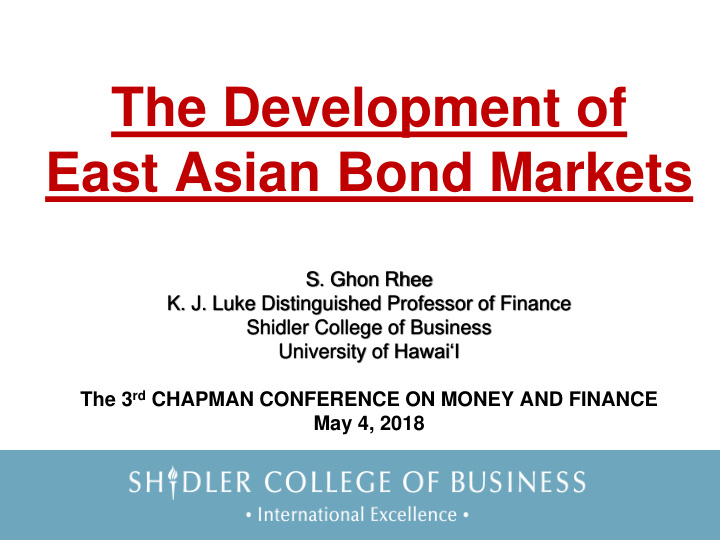



The Development of East Asian Bond Markets S. Ghon Rhee K. J. Luke Distinguished Professor of Finance Shidler College of Business University of Hawai‘I The 3 rd CHAPMAN CONFERENCE ON MONEY AND FINANCE May 4, 2018
Investors in US Treasury Securities as of 2017 Total Amount Held by East Asian Countries: Outstanding: $2.94 (20%) $14.47 trillion Held by Domestic Investors: $8.19 (57%) Held by Other Foreign Countries: $3.34 (23%)
Holdings of US Treasury Securities by East Asian Countries (2017) Unit: US$ Billion Holdings in Foreign % of FX Treasury Exchange Reserves Securities Reserves China $1,184.9 36.6 $3,235.9 Japan 1,061.5 84.0 1,264.3 Hong Kong 194.7 43.9 443.5 Taiwan 180.9 39.6 456.7 Singapore 125.0 44.7 279.9 Korea 96.2 24.3 395.8 Thailand 60.9 24.4 249.5 Total (Asia) 2,940.1 46.5 6,325.6 Source: US Department of the Treasury 3
One Question after Asian Financial Crisis was ….. Can FX Reserves be recycled within Asia? 4
ABMI (Asian Bond Market Initiative) ASEAN+3 Finance Ministers Creation of Regional Bond Market 5
ASEAN + 3 ASEAN member countries: Brunei Cambodia Indonesia Laos Malaysia Myanmar Philippines Singapore Thailand Vietnam +3 countries: China Japan Korea
East Asian Bond Markets Annual 1997 2017 Growth (%) China 87 8,739 25.9 Hong Kong 41 244 9.3 Indonesia 4 184 21.1 Korea 153 2,020 13.8 Malaysia 57 318 9.0 Philippines 17 110 9.8 Singapore 24 272 26.3 Thailand 10 346 19.4 East Asia w/o Japan 491 12,233 17.4 Japan 4,149 10,215 4.6 EU 6,936 22,902 6.2 United States 11,894 40,789 6.4 Unit: US$ Billion Sources: ADB; BIS; and Securities Industry and Financial Markets Association 7
Despite Remarkable Growth in East Asian Bond Markets… One Major Concern Remains ….It fails to serve as a regional market 8
Cross-Border Investment in East Asian Bonds remains small Unit: US$ Billion 2001 2017 Total Investments in $7,520 $27,459 Bonds (100%) (100%) Worldwide Total 226 1,290 Investments in (3%) (4.7%) East Asian Bonds Source: IMF CPIS (Coordinated Portfolio Investment Survey)
GDP (2017) GDP as of % of World 2017 GDP EA w/o Japan $16,757 22.3 Japan 4,884 6.5 EU9 12,742 16.9 United States 19,362 25,7 World GDP 75,278 100.0 Unit: US$ trillion Source: IMF
Cross-Border Investment in East Asian Bonds 2001 2017 Total Investments in 226 1,290 East Asian Bonds (100%) (100%) 13 61.5 a. By Japan (6%) (5%) 39 390.5 b. By East Asia (17%) (30%) b. By Rest of the 174 838.0 World (77%) (65%) Unit: US$ Billion Source: IMF Japan’s investment in bonds worldwide: US$2,521 billion Its investment in East Asian Bonds: Only 2.4% of total investment
Foreign Holdings of EA Corporate Bonds
Foreign Holdings of EA Corporate Bonds Corporate $ Amount of % of Foreign Bonds Foreign Investment Outstanding Investment (As of 2017) $29 $2.29 Indonesia 7.9% 2,413 9.41 China 0.39% 1,193 1.19 Korea 0.10% Unit: US$ Billion
What Happened to ABMI? ABMI Fizzled Out: Why? 1. Extreme Regionalism 2. Overemphasis on Public S ector’s Role 3. Preoccupation with Harmonization of Rules and Regulations 4. Lack of Transparency
Extreme Regionalism: Costly and Counterproductive Some Troubling Suggestions a. Bonds rated by Asian rating agencies b. Bonds issued by Asian borrowers and purchased by Asian investors c. Bonds traded, cleared, and settled in Asia “Asia Only” Market will a. Limit Number of bond buyers b. Discourage competition c. Increase borrowing cost
As long as Asian Borrowers Issue bonds at a minimum cost, does it matter? 1. Where these bonds are issued 2. Who rates these bonds 3. Who serves as lead managers 4. Where these bonds are traded 5. Where they are cleared and settled Regional markets must be a part of global markets rather than being a segmented and isolated market
Should Public Sector to Spearhead? a. Creation of a regional bond rating agency b. Creation of a regional clearing and settlement system c. Creation of a regional trading system Definitely NO
Pre-Occupation with Harmonization Harmonization is not necessary for financial market integration Regional efforts have overemphasized harmonization while elimination of impediments to capital flows has been largely overlooked “Putting the cart before the horse”
Lack of Transparency: An Example
EMEAP: ABF1 • Closed-End Fund launched in June 2003 • US$1 billion contributed by EMEAP central banks and managed by BIS • Invest in US$ denominated bonds issued by sovereign and quasi- sovereign issuers of 8 EMEAP members (except Japan, NZ, and AUS) • Closed in April 2016
EMEAP: ABF2 • Open-Ended Fund: Participation of Private Sector Encouraged launched in 2005 • US$2 Billion Investment contributed by EMEAP member central banks • Pan-Asian Bond Index Fund: – US$1 billion + private sector investment – Invest in local currency bonds issued by 8 member economies – Managed by State Street Global Advisors Singapore Ltd – Listed on the HKSE • Single-Market Country Funds – US$1 billion allocated to 8 single-market country funds – To be Listed on each country’s exchange
Transparency and Financial Disclosure Lacking • What are US$ bonds in ABF1? • How much private sector contributed to ABF2? • What are local currency bonds in Pan- Asian Bond Index Fund and 8 Single- Market Country Funds? • Price and Volume Behavior?
Looking Forward • As long as public sectors stay away from financial markets, EA bond markets will expand and develop due to robust EA economies • EA bond markets must be a part of global markets • One promising area: Municipal bond markets in China, Indonesia, Japan, and Korea
Thank You for Your Attention! 24
Recommend
More recommend